Articles
- Page Path
- HOME > J Korean Powder Metall Inst > Volume 28(1); 2021 > Article
-
Article
이산요소법을 이용한 Graphite 분말 압축 특성 연구 - 정준혁, 최진일*
- A Study on Graphite Powder Compaction Behaviors Using the Discrete Element Method
- Jun Hyeok Jeong, Jinnil Choi*
-
Journal of Korean Powder Metallurgy Institute 2021;28(1):1-6.
DOI: https://doi.org/10.4150/KPMI.2021.28.1.1
Published online: January 31, 2021
한밭대학교 기계공학과
Hanbat National University, Mechanical Engineering, Daejeon 34158, Republic of Korea
- *Corresponding Author: Jinnil Choi, TEL: +82-42-821-1083, FAX: +82-42-821-1083, E-mail: jlchoi@hanbat.ac.kr
- - 정준혁: 학생, 최진일: 교수
• Received: October 25, 2020 • Revised: January 1, 2021 • Accepted: January 4, 2021
© The Korean Powder Metallurgy Institute. All rights reserved.
- 876 Views
- 12 Download
- 1 Crossref
Abstract
- Accurate and effective powder compaction analyses are performed for brittle materials such as graphite, utilized as a solid lubricant, by using the discrete element method (DEM). The reliability of the DEM analysis is confirmed by comparing the results of graphite powder compaction analyses using the DEM particle bonding contact model and particle non-bonding contact model with those from the powder compaction experiment under the same conditions. To improve the characteristics, the parameters influencing the compaction properties of the metal-graphite mixtures are explored. The compressibility increases as the size distribution of the graphite powder increases, where the shape of the graphite particles is uniform. The improved compaction characteristics of the metal-graphite (bonding model) mixtures are further verified by the stress transmission and compressive force distribution between the top and bottom punches. It is confirmed that the application of graphite (bonding model) powders resulted in improved stress transmission and compressive force distribution of 24% and 85%, respectively.
- 분말 압축에서 분말과 분말, 분말과 Die 사이에서 발생 하는 마찰력을 감소시키기 위해 고체 윤활제인 Graphite 분말을 금속 분말과 혼합하는 방법이 많이 사용된다[1-4]. Graphite는 육각 기둥 격자 구조로 원자들은 공유 결합으 로 층을 형성하고 전단 외력에 의해 층과 층 사이가 파괴 되는 특성에 의해 마찰표면에서 윤활 작용을 수행할 수 있으므로 밀도가 중요한 파라미터인 압분체 제품을 생산 할 때 마찰력을 감소시켜 고밀도를 형성하는 역할을 한 다[5]. Graphite의 이런 특성에 의해 브레이크 패드와 같이 분말 야금으로 제작되어 열, 수분, 진동 등 다양한 조건에 서 강한 내구성 및 우수한 표면 마찰 특성을 발휘해야 하 는 제품을 제작하는 데 많이 활용된다[6]. 분말 압축 공정 은 폐쇄적인 Die 내에서 이루어지므로 압축 시 분말의 거 동에 따른 압축 특성을 확인하기 위해서는 입자 거동 예 측에 강점이 있는 DEM(Discrete Element Method, DEM) 해석 방법을 사용하는 것이 효율적이나[7], DEM 해석방 법에서 기본적으로 사용되는 입자 접촉 모델(Non-bonding model)은 입자를 강체로 정의하므로 Graphite와 같이 일정 압력에서 파괴되는 성질을 가진 재료의 거동을 정확하게 해석하는 데에는 어려움이 있다.
- 따라서 본 논문은 DEM의 결합 접촉 모델(Bonding model)을 이용하여 Graphite 분말 압축 해석의 정확성을 높이고, Graphite 혼합에 따른 압축 특성 변화에 관한 연 구를 수행하였다. Bonding model이 설정된 Graphite (Bonding) 압축 해석의 신뢰성을 확인하기 위해 Graphite (Bonding)와 Graphite(Non-bonding)를 각각 금속 분말 (Steel, Copper)과 혼합하여 압축한 DEM 결과를 분말 압 축 실험 결과와 비교하였고, Graphite(Bonding) 압축 시 유 동성에 의한 압축 특성을 확인하기 위해 크기 범위와 입 자 형상에 관한 연구를 진행하였다. 금속 분말(Steel)을 기 준으로 선정된 Graphite(Bonding)의 크기 범위와 입자 형 상 조건이 적용된 Steel-Graphite(Bonding) 혼합체의 향상 된 압축 특성을 확인하기 위해 상하부 Punch 사이의 응력 전달률과 압축력의 분산을 확인하여 DEM의 Bonding model이 적용된 Graphite 분말 압축 해석의 우수성을 확인 하였다.
1. 서 론
- DEM을 이용한 Graphite 분말 압축의 신뢰성을 확인하 기 위해 금속 분말(Steel, Copper)과 Graphite의 Bonding model, Non-boding model 혼합체의 압축 해석 결과와 실 험 결과를 비교하였다. Table 1은 분말 압축에 사용된 분 말의 기계적 물성값과 입도, 압축 장비의 기계적 물성값을 나타내며, 금속 분말(Steel, Copper)과 혼합되는 Graphite 의 혼합 비율은 1 wt%, 분말의 크기는 금속 분말(Steel, Copper)이 각각 20 μm, Graphite는 20 μm, 30 μm, 80 μm 로 선정하였고, Die 내의 분말 충진율은 약 80%, 압축 압 력은 Steel = 180 MPa, Copper = 85 MPa까지 진행하였다. Graphite의 적절한 크기 범위를 선정하기 위해 금속 분말 의 크기 20 μm를 기준으로 1배, 1.5배, 4배인 Graphite를 50 : 50 wt% 비율로 혼합한 크기 범위 모델을 선정하였고, Graphite의 입자 형상에 따른 압축 특성을 확인하기 위해 4가지 형상의 Graphite를 선정하여 DEM 해석을 진행하였다.
- DEM 해석 및 분말 압축 실험은 Fig. 1과 같이 Plate press가 Top punch를 수직 방향으로 가압하여 Die 내 Top punch와 Bottom punch 사이에서 Z 방향 1축 응력으로 분 말을 압축하였다. 압축 장비의 크기는 Top punch의 지름 이 20 mm, Die의 지름은 20 mm, 높이는 50 mm로 제작되 었고, 재질은 Table 1에 제시된 것과 같이 SKD-11을 사용 하였다.
- Steel, Copper는 강도와 탄성 한계가 비교적 높은 재료 로 Fig. 2(a)와 같이 입자를 강체로 정의하며 Spring, Damper 요소를 통해 입자 접촉 시 법선력과 접선력을 계 산하여 입자의 거동을 예측하는 Hertz Mindlin 접촉 모델 (Non-bonding model)을 사용하였고[8-10], Graphite와 같 이 일정 압력에서 파괴되는 재료는 Bonding model을 설 정하였다. Bonding model은 Fig. 2(b)와 같이 입자가 서로 결합한 상태로 생성되어 설정 압력 이상이 가압될 경우 Bonding area가 파괴되어 입자가 분리되는 입자 접촉 모 델이다[11-13]. Graphite의 입자 간 결합력은 Graphite의 탄성 영역이 끝나는 것을 기준으로 7 0MPa로 설정하였고, 마찰 계수는 냉간 저압 조건[14, 15]으로 0.1, Time step은 약 30%로 설정하였다.
2. 실험 방법
- 3.1 Graphite Bonding, Non-bonding, Experiment 비교
- DEM을 이용한 정확한 입자 해석을 수행하기 위해서는 재료의 특성과 용도에 맞는 입자 접촉 모델을 선정해야 한다. 본 연구에서는 DEM을 이용하여 Graphite의 취성을 고려한 분말 압축 결과를 확인하기 위해 기본 입자 접촉 모델(Hertz Mindlin)이 적용된 Steel, Copper 분말과 각각 Bonding model, Non-bonding model(Hertz Mindlin)이 적 용된 Graphite를 혼합하여 분말 압축 실험과 비교하였다. Fig. 3은 Steel-Graphite, Copper-Graphite 혼합체의 DEM 해석과 분말 압축 실험 결과로 DEM 해석의 경우, 두 혼 합체 모두 Graphite(Bonding)가 혼합되었을 때 분말 압축 실험 그래프와 유사한 기울기를 나타내었다. 분말 압축 실 험 결과와 DEM의 Steel-Graphite(Bonding) 혼합체 압축 변위 변화량은 91% 일치하고, Steel-Graphite(Non-bonding) 는 87%, Copper-Graphite(Bonding)는 88%, Copper-Graphite (Non-bonding)는 7 1% 일치하였다. 이 결과를 통해 DEM 의 Bonding model을 이용한 Graphite 압축 해석이 실제 압축 실험과 유사한 경향을 확인함으로써 Bonding model 이 적용된 Graphite 압축 해석의 신뢰성을 확인하였다.
- 3.2 Graphite의 크기 범위 및 형상
- 고체 윤활제는 분말과 분말, 분말과 장비 사이의 마찰 표면을 이동하며 윤활 작용을 수행하므로 고체 윤활제의 유동성에 영향을 끼치는 요소인 입자의 크기를 적절히 선 정해야 한다. 하지만 Graphite의 경우, 취성에 의해 분말의 크기 범위가 넓으므로 Graphite의 압축 해석을 수행할 경 우에는 다양한 크기 범위를 고려해야 한다. Fig. 4는 Steel 을 기준으로 Graphite 크기를 1 : 1, 1 : 1.5, 1 : 4 비율로 혼 합하여 압축한 결과로 Graphite의 크기가 일정할수록 압축 변위가 증가하였고, Steel-Graphite 압분체에 적용된 압축 력은 Graphite의 크기 범위가 좁을수록 더욱 고르게 분산 된 것을 확인하였다.
- 분말 압축은 일반적으로 1차 저압 단계, 2차 고압 단계 로 진행되며[16], 1차 저압 단계에서는 분말들이 이동하며 배열되므로 이 과정에서 고체 윤활제의 유동적인 거동이 중요하다. 고체 윤활제의 유동성을 결정하는데 입자의 형 상은 중요한 요소이며, Graphite의 경우 일반적으로 제조 방법에 따라 플레이크 형과 구형 입자로 구분된다. 본 연 구에서는 Graphite의 불 균일한 플레이크 형상 입자 3개와 구 형상 입자의 압축 특성을 비교하여 Graphite 혼합 시 적절한 형상을 선정하는 연구를 진행하였다. Fig. 5에서 형상별 입자 한 개의 평균 변위는 Type 1 = 2.95 mm, Type 2 = 2.39 mm, Type 3 = 2.29 mm, Type 4 = 1.94 mm이며, 압분체의 구간을 나누어 Graphite 입자의 분산률을 확인한 결과는 Type 1 = 88%, Type 2 = 41%, Type 3 = 38%, Type 4 = 27 %로 분석되어 Type 1 입자의 유동성이 가장 우수함 을 확인하였다. 이 결과를 바탕으로 Steel과 Graphite의 입 자 형상별 압축률 결과는 Type 1 입자가 혼합된 Steel- Graphite 혼합체의 압축률이 가장 많이 증가하였다. 구 형 상의 Graphite는 금속분말과 혼합되었을 때 플레이크 형상 보다 경도, 상대밀도, 마모율 등의 기계적 특성이 우수하 고 응력 집중이 완화된 연구 결과[17]에 따라 분말 압축 시 구 형상 Graphite의 우수한 유동성에 의해 압축 특성이 향상된 것으로 판단된다.
- 3.3 응력 전달 및 압축력 분산
- 분말 압축 시 Punch 사이의 높은 응력 전달률은 Die wall 마찰, 분말과 분말 사이의 마찰에 의한 응력 손실이 적어 분말로 응력이 원활히 전달되었다는 것을 나타내며, 분말의 1차 저압 압축 단계에서는 분말과 분말 사이의 마 찰 감소의 중요성이 증가한다[18]. 본 연구에서는 Graphite 의 크기 범위와 입자 형상에 관한 연구에서 선정된 Steel- Graphite 혼합체의 응력 전달률을 DEM 해석을 이용하여 확인하였다. Fig. 6은 Steel-Graphite(Bonding) 혼합체와 Steel-Graphite(Non-bonding) 혼합체 압축 시 Punch에 적용 되는 응력을 나타낸 결과로 Steel-Graphite(Bonding) 혼합 체는 Fig. 3의 Steel-Graphite 혼합체의 실험 결과와 유사 한 기울기를 나타내지만 Steel-Graphite(Non-bonding) 혼합 체 그래프는 실험 결과와 다른 경향을 확인함에 따라 DEM을 이용한 Graphite 압축 해석에서 Bonding model의 신뢰성을 검증하였다. Steel의 응력 전달률을 기준으로 Steel-Graphite(Bonding) 혼합체의 응력 전달률이 약 24%, Steel-Graphite(Non-bonding) 혼합체의 응력 전달률이 약 18% 증가한 결과를 확인하였고, 이 결과는 Graphite의 혼 합이 분말 압축 시 분말간 접촉에 의한 마찰을 감소시켜 응력이 집중되는 현상을 방지함에 따라 응력 전달률을 증 가시킨 것으로 판단된다.
- 분말 압축 시, 압축력이 일정 부분에 집중되면 잔류 응 력이 발생하여 압분체의 내구성을 감소시키므로 압축력을 고르게 분산시키는 것이 중요하다[19]. Fig. 7은 DEM을 이용하여 Steel, Steel-Graphite(Bonding), Steel-Graphite (Non-bonding) 혼합체의 압축력 분산을 확인하기 위해 압 분체를 12구간으로 나누어 분말에 작용한 압축력 표준 편 차를 계산하여 압축력 분산을 확인하였다. Steel을 기준으 로 Steel-Graphite(Bonding) 혼합체의 압축력 표준편차는 약 85% 감소하였고, Steel-Graphite(Non-boding) 혼합체는 약 7 5% 감소하였다. 이 결과를 통해 DEM을 이용한 분말 압축 해석에서 Graphite와 같은 취성 재료에 Bonding model을 적용함으로써 검증된 분말 압축 해석을 바탕으로 향상된 압축력 분산 결과를 확인하였다.
3. 결과 및 토론
Fig. 4
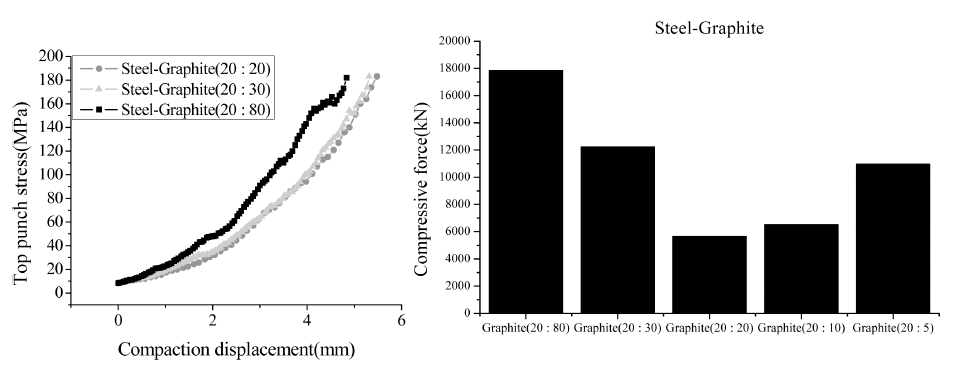
Graphs of displacement against stress with different graphite size ranges and standard deviation of compressive force of Steel-Graphite mixtures.

Fig. 6
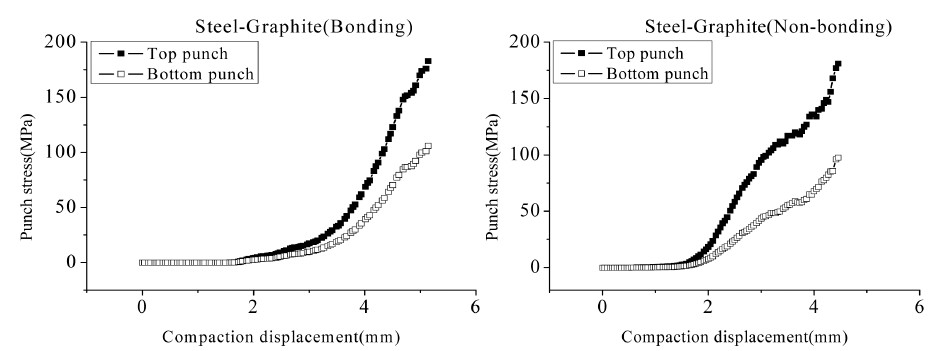
Stress transmission of Steel-Graphite (Bonding) and Steel-Graphite (Non-bonding) powder mixtures.

- 분말 압축 시, 초기 압축 단계에서는 분말 입자가 이동 하며 배열되고, 압분체 밀도의 80~90%가 형성되므로 Graphite의 취성에 의한 거동을 확인하기 위해서는 압축 초기 단계에서의 연구가 중요하다[20]. 본 논문은 DEM을 이용하여 Graphite 압축 해석 시 취성이 고려된 압축 특성 을 확인하기 위해 DEM의 입자 결합 모델(Bonding model)을 이용하여 해석의 정확성을 확인하였다. DEM을 이용한 Graphite 압축 해석의 정확성을 확인하기 위해 Steel, Copper와 Bonding, Non-bonding model이 적용된 Graphite 혼합체를 분말 압축 실험과 비교한 결과 Bonding model이 적용된 Graphite를 혼합하였을 때 실험 결과와 유 사한 경향을 확인하였다. Graphite의 크기 범위 연구에서 는 Graphite의 크기가 작아질수록 압축 변위가 증가하고, Graphite의 크기 범위가 좁아질수록 압축력의 편차가 감소 하였다. 이 결과는 균일하고 작은 Graphite 입자의 크기 분포가 분말 배열을 균일하게 하고, 압축력을 분산시켜 압 축 특성 향상시킨 것으로 판단된다. Graphite의 입자 형상 연구에서는 구 형상의 Graphite가 평균 변위, 분산률, 압축 률이 가장 우수하였다. 이 결과는 유동성이 좋은 구 형상 의 Graphite가 분말 입자 사이를 원활히 움직이며 윤활작 용을 수행하여 압축 특성이 향상된 것으로 판단된다. 크기 범위와 입자 형상 연구에서 선정된 Steel-Graphite 혼합체 의 응력 전달률은 Steel을 기준으로 약 24% 증가하였고, 압축력 표준 편차는 약 85% 감소하였다.
- 위 결과를 통해 DEM을 이용한 Graphite 분말 압축 해 석에서 취성이 고려된 압축 해석의 정확성 향상과 금속 분말 압축 시 Graphite 혼합에 따른 압축 특성 향상을 확 인함에 따라 고 내구성의 분말야금제품 생산 연구에 기여 할 수 있다.
4. 결 론
- 1. P. R. Gibson, A. J. Clegg and A. A. Das: Wear, 92 (1984) 193. .Article
- 2. H. Nayeb-Hashemi, J. T. Blucher and J. Mirageas: Wear, 150 (1991) 21. .Article
- 3. A. G. Wang and I. M. Hutchings: Mater. Sci. Technol., 5 (1989) 71. .Article
- 4. G. Goller, D. P. Koty, S. N. Tewari, M. Singh and A. Tekin: Metall. Mater. Trans. A, 27 (1996) 3727. .Article
- 5. H. Y. Yang, J. H. Kim, Y. W. Kim, J. S. Ha, S. H. Park and H. K. Lee: J. Korean Soc. Propulsion Eng., 17 (2013) 95. .Article
- 6. R. Gilardi, L. Alzati, M. Thiam, J. F. Brunel, Y. Desplanques, P. Dufrenoy, S. Sharma and J. Bijwe: Materials, 5 (2012) 2258. .ArticlePMC
- 7. Y. Sheng, C. J. Lawrence, B. J. Briscoe and C. Thornton: Eng. Comput., 21 (2004) 304. .Article
- 8. J. F. Jerier, B. Hathong, V. Richefeu, B. Chareyre, D. Imbault, F. V. Donze and P. Doremus: Powder Technol., 208 (2011) 537. .Article
- 9. M. Ucgul, J. M. Fielke and C. Saunders: Biosyst. Eng., 129 (2015) 298. .Article
- 10. C. Santos, V. Urdaneta, X. Garcia and E. Medina: Geophysics, 76 (2011) 165. .Article
- 11. P. W. Cleary and M. D. Sinnott: Miner. Eng., 74 (2015) 178. .Article
- 12. P. A. Cundall and O. D. L. Strack: Géotechnique, 29 (1979) 47. .Article
- 13. D. O. Potyondy and P. A. Cundall: Int. J. Rock Mech. Min. Sci., 41 (2014) 1329. .Article
- 14. C. L. Martin: J. Mech. Phys. Solids, 52 (2014) 1691. .Article
- 15. N. A. Fleck: J. Mech. Phys. Solids, 43 (1995) 1409. .Article
- 16. C. L. Martin, D. Bouvard and S. Shima: J. Mech. Phys. Solids, 51 (2003) 667. .Article
- 17. Y. Sun, Y. Wang, Y. Li, K. Zhou and L. Zhang: Trans. Nonferrous Met. Soc. China, 30 (2020) 2177. .Article
- 18. A. Simchi: Mater. Des., 24 (2003) 585. .Article
- 19. S. Brown and G. Abou-Chedid: J. Mech. Phys. Solids, 42 (1994) 383. .Article
- 20. E. Olsson and P. L. Larsson: Powder Technol., 243 (2013) 71. .Article
Figure & Data
References
Citations
Citations to this article as recorded by 

- Effects of solid graphite lubricants for powder compaction
Jun Hyeok Jeong, Jinnil Choi
Powder Metallurgy.2021; 64(3): 241. CrossRef
A Study on Graphite Powder Compaction Behaviors Using the Discrete Element Method
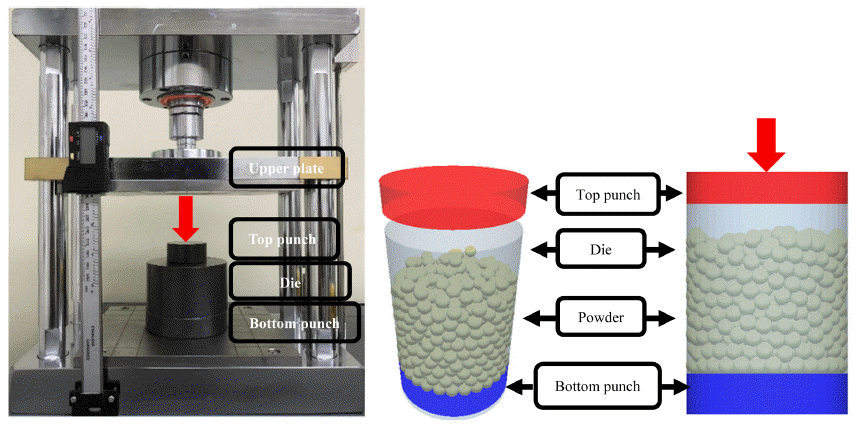

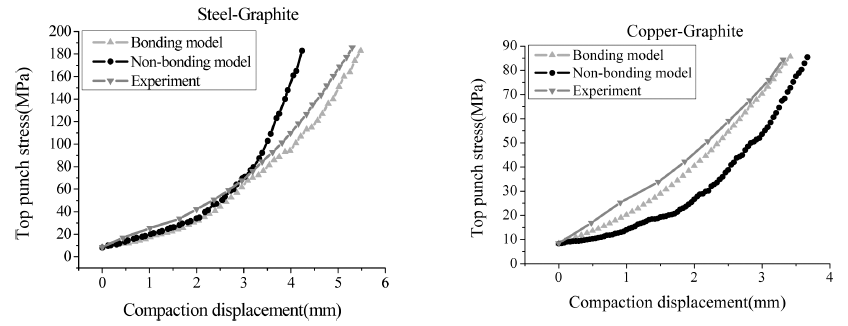

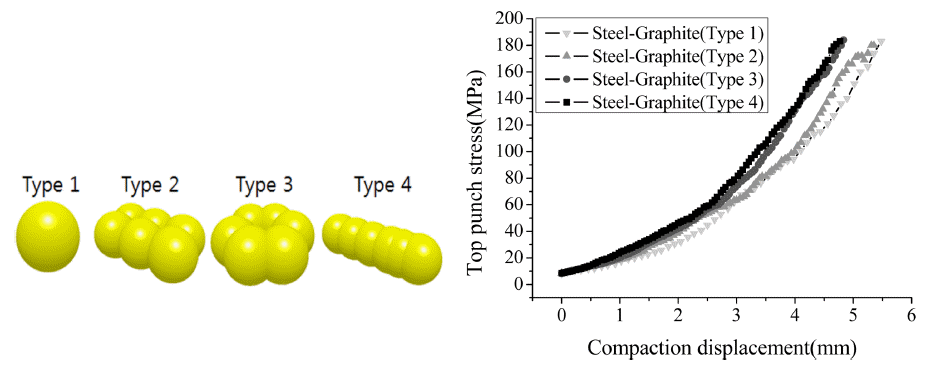


Fig. 1
Experimental apparatus (left) and DEM model (right) for powder compaction.
Fig. 2
(a) Hertz Mindlin particle contact model and (b)particle bonding contact model.
Fig. 3
Graphs of displacement against stress with particle contact model and experiment.
Fig. 4
Graphs of displacement against stress with different graphite size ranges and standard deviation of compressive force of Steel-Graphite mixtures.
Fig. 5
Graph of displacement against stress with different graphite shapes.
Fig. 6
Stress transmission of Steel-Graphite (Bonding) and Steel-Graphite (Non-bonding) powder mixtures.
Fig. 7
Standard deviation of compressive force of Steel, Steel-Graphite (Bonding) and Steel-Graphite (Non-bonding) powder mixtures.
Fig. 1
Fig. 2
Fig. 3
Fig. 4
Fig. 5
Fig. 6
Fig. 7
A Study on Graphite Powder Compaction Behaviors Using the Discrete Element Method
Table 1
Mechanical properties of Steel, Copper and Graphite powders and compaction die
Table 1
TOP
 KPMI
KPMI



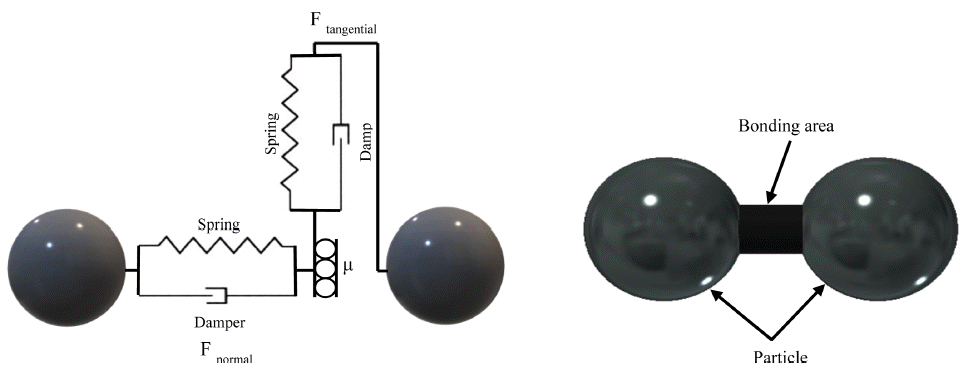


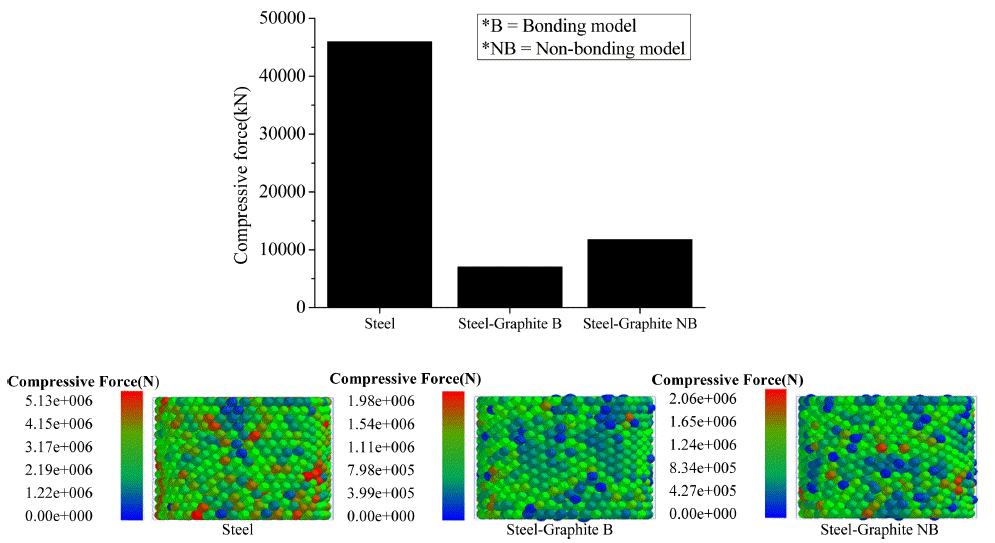
 ePub Link
ePub Link Cite this Article
Cite this Article







